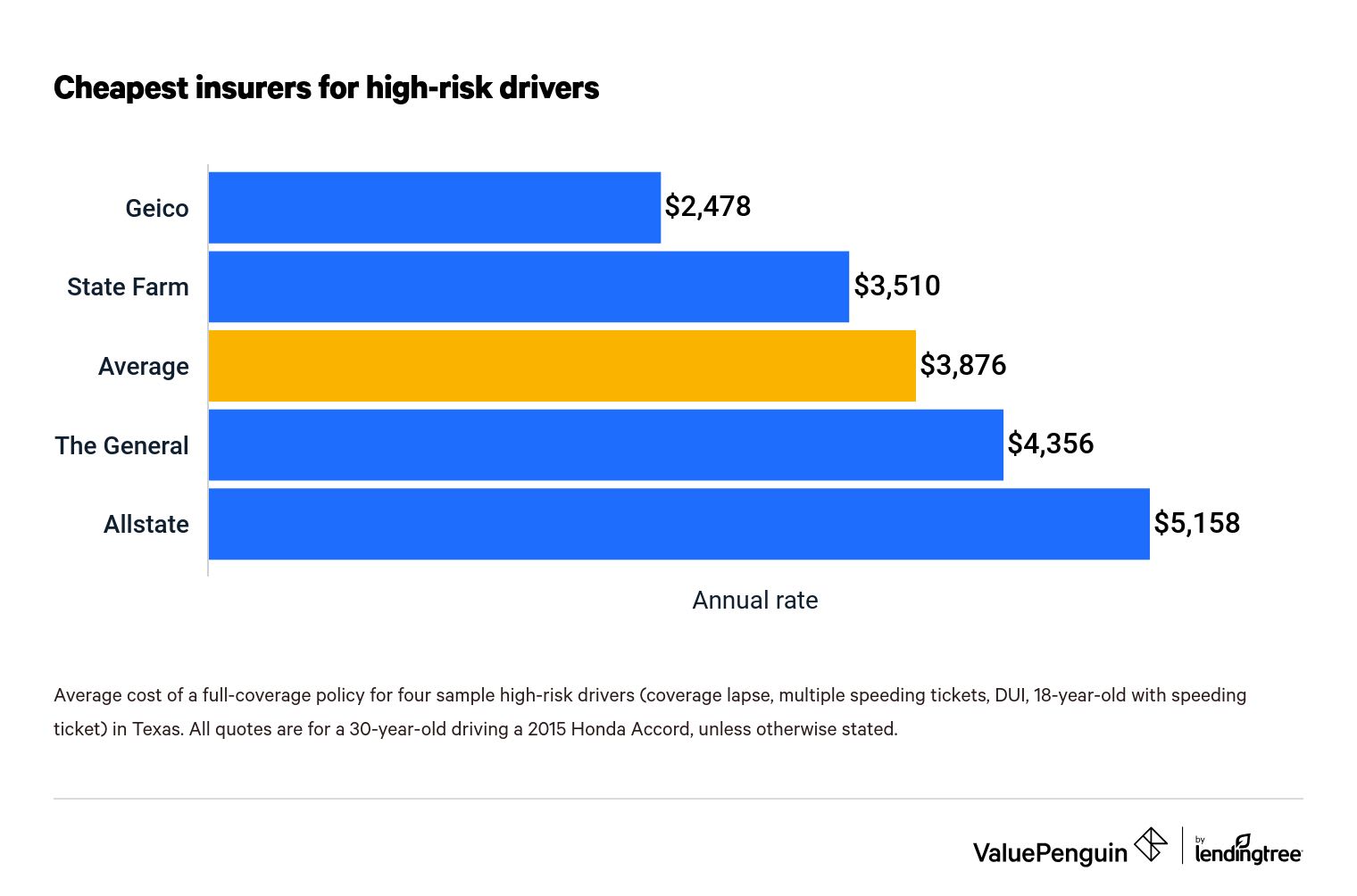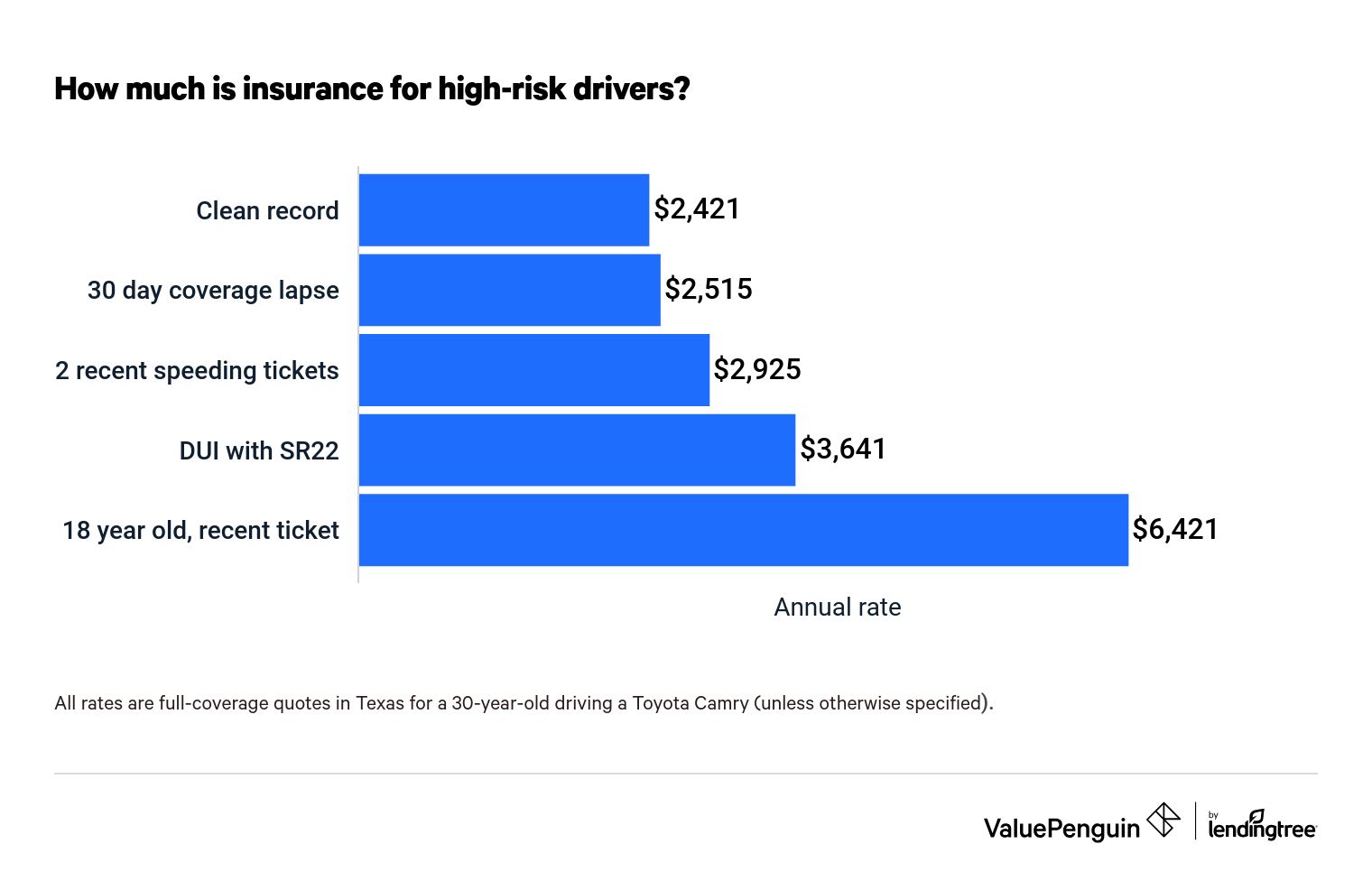Best Cheap Car Insurance for High-Risk Drivers
If you have a traffic citation, lack driving experience or have poor credit, then insurance companies may consider you a high-risk driver — and charge higher rates or refuse to give you a policy. But there's still hope. Plenty of reputable companies will insure people with a bad driving record. And if you're having trouble finding insurance, your state-sponsored auto insurance program may offer you an option.
Find Cheap Auto Insurance Quotes in Your Area
You can find the cheapest companies in your area with high-risk plans by getting a free online insurance quote.
We gathered thousands of quotes for drivers with four different violations that make them high-risk from every ZIP code in Texas. ValuePenguin looked at three major national insurers, State Farm, Geico and Allstate, as well as The General, which specializes in covering drivers with issues on their records.
Which companies offer the cheapest high-risk auto insurance?
Geico has the lowest rates for high-risk drivers, with average rates that are 36% less expensive than others.
If your driving history puts you into one of the high-risk categories, some companies may have cheaper car insurance rates than others.
Geico consistently has the cheapest high risk car insurance. It has cheap quotes for drivers who have a speeding ticket, a DUI or a lapse in coverage and young drivers who have a ticket. State Farm is another affordable company.

Find Cheap Auto Insurance Quotes in Your Area
Coverage lapse
Speeding tickets
DUI
Teen with ticket
Full-coverage rates after a 30-day coverage lapse
Company | Monthly rate | |
|---|---|---|
| Geico | $117 | |
| State Farm | $172 | |
| The General | $263 | |
| Allstate | $286 | |
Coverage lapse
Full-coverage rates after a 30-day coverage lapse
Company | Monthly rate | |
|---|---|---|
| Geico | $117 | |
| State Farm | $172 | |
| The General | $263 | |
| Allstate | $286 | |
Speeding tickets
Full-coverage rates after two recent speeding tickets
Company | Monthly rate | |
|---|---|---|
| Geico | $188 | |
| State Farm | $238 | |
| The General | $263 | |
| Allstate | $286 | |
DUI
Full-coverage rates after a DUI with an SR-22
Company | Monthly rate | |
|---|---|---|
| Geico | $217 | |
| State Farm | $252 | |
| The General | $292 | |
| Allstate | $453 | |
Teen with ticket
Full-coverage rates for an 18-year-old with a recent ticket
Company | Monthly rate | |
|---|---|---|
| Geico | $304 | |
| State Farm | $508 | |
| The General | $634 | |
| Allstate | $695 | |
In addition to higher rates, higher-risk drivers may also have fewer companies to choose from. It's possible that some insurers won't give you a quote at all.
However, get quotes from several major auto insurance companies before switching to a nonstandard insurer. Nonstandard companies tend to have higher prices and worse customer service than typical insurers. So if you can find a standard company that will sell you a policy, it's often worth it — even if it takes extra effort.
For example, The General doesn't offer affordable rates to high-risk drivers. However, if you can't get coverage from a mainstream company, a high-risk auto insurance company like The General may be the best option available.
How to get car insurance if you've been denied coverage
Almost every state requires drivers to have car insurance, but some insurance companies may deny coverage to high-risk drivers.
In this case, there are two main options to look into: nonstandard insurance companies and state-sponsored automobile insurance plans. Unfortunately, both tend to charge higher rates to drivers than mainstream companies.
Nonstandard insurance companies are simply companies that specialize in offering coverage to people who are having trouble getting a quote from another company. Nonstandard insurers tend to be available regionally, but national companies include The General, Safe Auto and National General.
State-sponsored auto insurance plans
State | Insurance plan |
|---|---|
| Alabama | Alabama Automobile Insurance Plan (AL AIP) |
| Alaska | Alaska Automobile Insurance Plan (AK AIP) |
| Arizona | Arizona Automobile Insurance Plan (AZ AIP) |
| Arkansas | Arkansas Automobile Insurance Plan (AR AIP) |
| California | California Automobile Assigned Risk Plan (CAARP) |
Who is an at-risk driver?
A prior DUI offense, traffic tickets, at-fault accidents, age, lapses in insurance coverage and credit scores can all affect your risk profile — and influence your auto insurance rate.
Most common high-risk factors
How much more you'll pay as an at-risk driver varies. But the more factors that apply to you, the higher your rates will be. Younger drivers with a ticket or accident on their records have the highest rates overall.
Not every state uses driver's license points, but many of these high-risk factors will add points to your license too. And too many points on your license could lead to a suspended license.
DUI offense
If you've been convicted of driving under the influence, your rates will increase. Once you get your license back, your car insurance company may need to file an SR-22 form on your behalf to confirm that you have coverage that meets the state requirements. You may need to keep the SR-22 form on file for several years, and you'll pay higher insurance rates as a high-risk driver.
Multiple tickets
While one speeding ticket may not put you in the high-risk category, if you get multiple violations or a ticket for driving much faster than the speed limit, you're likely to have trouble finding an affordable rate.
Most companies will offer discounts for taking a defensive driving course. This can help you lower your rates, even if you have points on your license.
Young or first-time drivers
Research has shown that young drivers are more likely to display risky driving behavior and get into car accidents, so insurance companies raise their rates.
Regardless of age, new drivers always pay more than experienced drivers. The best way to work around this rule is to add new drivers to a family policy. This shortcut helps young drivers get cheaper auto insurance coverage than they would get buying their own policies.
Lapse in insurance coverage
If you let your car insurance lapse, either by canceling your policy or not paying your bill, your rates will be higher when you reapply. This is because a lapse in coverage shows insurers that you may not be reliable financially. And depending on the length of the lapse, some insurers may not offer you coverage at all.
The good news is that over time, and once you prove to the insurance company that you're a responsible driver, your rates should drop back down to normal. The bad news is that it may take six months or more for your rates to improve.
Poor credit
People who have a poor credit history are also considered high-risk drivers. Even if you drive safely, having poor credit means you'll pay more for car insurance. Insurers have seen a link between poor credit and risky driving behavior.
Fortunately, there are some insurance companies that don't do credit checks — but you'll have to shop around. And a few states ban insurers from using credit history when calculating rates.
Other serious driving violations
Your insurance rates will also spike if you have any type of serious driving violation — such as hit and run, road rage, reckless driving or speeding. Higher insurance rates may be the least of your worries, however, as some of these violations can be considered felonies that could lead to jail time.
How can I find high-risk auto insurance?
The first step to find a good rate for a driver with a bad record is to get a free online insurance quote from multiple insurers and compare rates to choose the best plan.
How can I prove I'm a safe driver?
- Improve your credit score
- Get good grades as a student
- Take defensive driving classes after a ticket
- Set your insurance bill to autopay so you don't miss a payment
Find Cheap Auto Insurance Quotes in Your Area
Being a high-risk driver doesn't last forever.
While insurance companies may view you as high-risk today, you'll be happy to know your rates will go down over time as you prove you're a safe and responsible driver. Yes, getting a DUI will mean paying higher rates for a longer period. But most high-risk drivers will start seeing lower rates after a year or two.
Frequently asked questions
What is a high-risk driver?
A high-risk driver is someone who insurance companies think is more likely to make a claim or be in a crash than a typical driver. If you are young, have multiple tickets or accidents on your record or have let your insurance lapse, you're likely in the high-risk category.
How much is high-risk insurance?
Being high-risk can increase your rates by as little as 4%, or as much as 165%. How much more you'll pay as a high-risk driver will vary based on what makes you high-risk, how long ago the incident was and where you live.
What is the best insurance for high-risk drivers?
Geico is the best car insurance company for high risk drivers. Drivers with very bad records may need a nonstandard company like The General or Safe Auto. Or, you could get a policy through your state's high-risk insurance plan.
Methodology
Surveyed auto insurance costs are for illustrative purposes only. Actual quotes will vary based on where you live, your driving history and other factors. ValuePenguin's analysis used insurance rate data from Quadrant Information Services. These rates were publicly sourced from insurer filings.
Editorial Note: The content of this article is based on the author's opinions and recommendations alone. It has not been previewed, commissioned or otherwise endorsed by any of our network partners.





